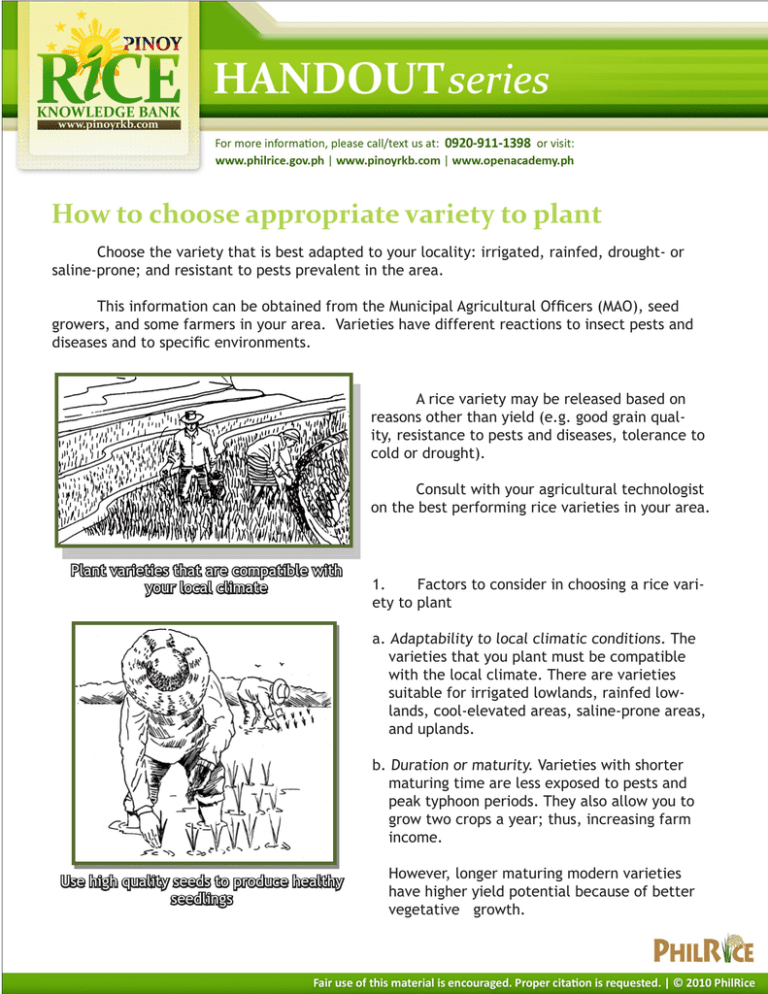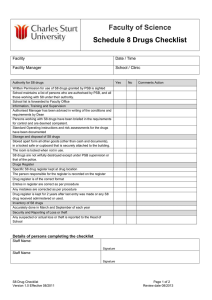How to choose appropriate variety to plant
advertisement

How to choose appropriate variety to plant Choose the variety that is best adapted to your locality: irrigated, rainfed, drought- or saline-prone; and resistant to pests prevalent in the area. This information can be obtained from the Municipal Agricultural Officers (MAO), seed growers, and some farmers in your area. Varieties have different reactions to insect pests and diseases and to specific environments. A rice variety may be released based on reasons other than yield (e.g. good grain quality, resistance to pests and diseases, tolerance to cold or drought). Consult with your agricultural technologist on the best performing rice varieties in your area. Plant varieties that are compatible with your local climate 1. Factors to consider in choosing a rice variety to plant a. Adaptability to local climatic conditions. The varieties that you plant must be compatible with the local climate. There are varieties suitable for irrigated lowlands, rainfed lowlands, cool-elevated areas, saline-prone areas, and uplands. b. Duration or maturity. Varieties with shorter maturing time are less exposed to pests and peak typhoon periods. They also allow you to grow two crops a year; thus, increasing farm income. Use high quality seeds to produce healthy seedlings However, longer maturing modern varieties have higher yield potential because of better vegetative growth. c. Tolerance to drought. Varieties that can thrive under dry conditions for some time are advantageous especially when the crop is dry seeded or when irrigation is delayed. Varieties for rainfed and upland areas have some degrees of drought tolerance. Some of these varieties are PSB Rc1, PSB Rc14, PSB Rc16, PSB Rc36, PSB Rc38, PSB Rc40, PSB Rc42, and NSIC Rc222. NSIC Rc192, for example, is suitable under fluctuating moisture conditions. d. Tolerance to pests. Use varieties that are resistant to major pests common in your locality. Matatag 3 and 6 show tolerance to the tungro virus. e. Tolerance to problem soils. There are varieties that grow even in adverse soil conditions such as saline soils, zinc-deficient soils, phosphorus and iron-deficient soils, soils with excess manganese and aluminum, and toxic soils. PSB Rc1, for example, is suited for acidic soils while PSB Rc48, PSB Rc50, PSB Rc84, PSB Rc86, PSB Rc88, and PSB Rc90 are suited for saline-affected soils. New varieties such as NSIC Rc182 (Salinas 1), NSIC Rc184 (Salinas 2), NSIC Rc186 (Salinas 3), NSIC Rc188 (Salinas 4), and NSIC Rc190 (Salinas 5) show moderate salinity tolerance with acceptable yields. f. Resistance to lodging. The factors that affect lodging are: plant height, light intensity, spacing, amount of soil fertility, the method of crop establishment, wind velocity and rain, type of sheath, stem thickness, and root structure. Some of the varieties resistant to lodging include PSB Rc2, PSB Rc30, PSB Rc34, and PSB Rc74. g. Tolerance to water submergence. This characteristic is especially important when there is continuous rain and the floodwater does not recede in 2-3 days. NSIC Rc194 or Submarino 1 is tolerant to submergence up to 14 days at vegetative stage only. 2.Note that the variety that you may choose does not have to possess all of the abovementioned characteristics. Select varieties that meet the needs and problems of your particular locality. 3.Minimize pest problems in your farm by practicing synchronous planting. This means you and your neighboring farmers (covering at least 20-hectare contiguous farm) should plant your rice crop within a month. 4.Plant certified seeds or good seeds of improved varieties suited to your farm. Certified seeds are 98% pure, clean, full, uniform in size, and have a minimum germination rate of 85%. Use of certified seeds leads to healthy seedlings that grow faster and uniformly. All this can contribute to a 5-10% increase in yield. 5.Remember that healthy seedlings have more roots, grow faster, and produce a more even stand than poor quality seedlings. Thus, good quality seeds ensure higher yields. Reviewed by: Thelma F. Padolina




